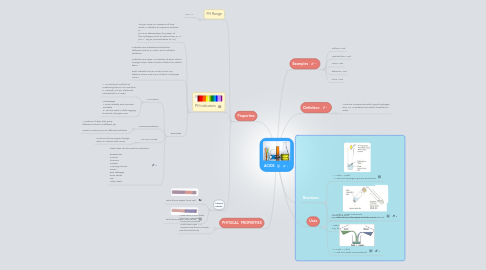
1. PHYSICAL PROPERTIES
1.1. Acids have a sour taste (Lemons, oranges) Acids are corrosive Acids have a pH > 7 Aqueous solutions of acids conduct electricity
2. Properties
2.1. PH Range
2.1.1. PH < 7
2.2. PH indicators
2.2.1. The pH scale is a measure of how acidic or alkaline an aqueous solution is pH is an abbreviation for power of the Hydrogen and has values from 0-14. pH = - log10 (concentration of H+)
2.2.2. Indicators are substances that show different colours in acidic and in alkaline solutions. Indicators are dyes, or mixtures of dyes, which change colour when acids or alkalis are added them Each indicator has an acidic colour, an alkaline colour and a pH at which it changes colour
2.2.3. Examples
2.2.3.1. PH Meters
2.2.3.1.1. 1. an electrical method of measuring the pH of a solution 2. consists of a pH electrode connected to a meter
2.2.3.1.2. Advantages 1. more reliable and accurate portable 2. can be used in data logging to record changes in pH
2.2.3.2. Universal indicator
2.2.3.2.1. A mixture of dyes that gives different colours at different pH. Used to measure pH of different solutions
2.2.3.3. LITMUS PAPER
2.2.3.3.1. Colours of limus paper change when in contact with acids.
2.2.3.4. Plants that can be used as indicators Blueberries Carrots Cherries Grapes Morning Glories Onion Red cabbage Rose Petals Tea Tulip Petals
2.3. Litmus Paper.
2.3.1. Blue litmus paper turns red.
2.3.2. Red litmus paper turns blue.
